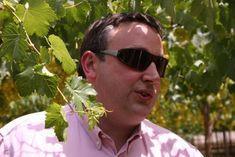



murcia did not escape the general weather malaise that afflicted Spanish growing areas throughout last winter and spring. Unhelpful conditions during the key flowering period have put back the 2004 grape campaign by 10-14 days, while also diminishing crop volume prospects.
“The general consensus was that there would be a 10 per cent increase in the crop, but that isn’t likely to happen now,” says Gavin Pearce of AMC Muñoz. “We have experienced a very mild spring, with little sunlight, low temperatures and rain throughout flowering - the exact opposite to what we would have liked.”
While there is plenty of fruit around, the mild spring delayed setting and has caused a few problems with sizing, which will in turn reduce marketable fresh volumes. Sendings to the UK market will remain unaffected, and largely unchanged on last season, however, at around 8,500 tonnes. The likely end of the season will also be put back, with growers predicting a finish around August 10.
“The early part of the season will be so so, but the full season is going to be a good one,” says Enrique Moya of Frutas del Guadalentín. “I think it will split the season in two and the sizing differentials in bunches will complicate the grading process. It will be harder work in the fields and the packhouses, but quality is outstanding and I think we will all be happy at the end of the season.”
Rupert Maude at El Ciruelo adds: “It will undoubtedly be a difficult season, without the same quality as last year. We will have to put in a lot more work to achieve the same results. The grapes we send to the UK are mostly packed in the field, so an initial selection there is followed by further grading at the packhouse. Getting this right will be crucial this year.
“The natural three week season has been extended by the use of covers for much of the Superior crop, but some of that has been lost this year. Performance under plastic netting is more uniform on a five-year average, but this year’s early grape was affected and doesn’t fit into the pattern.”
Esther Gómez Yelo at Frutas Esther, in Abaran, concurs with her counterparts in the region, adding: “I don’t think quality will be affected at all, particularly fruit that is destined to the UK market.” Technical manager Rafael Perez added: “Almost 100 per cent of our Superior Seedless® goes to the UK and we would expect the season to pick up as it progresses.”
A landmark court case five years ago effectively stamped out illegal branding of Spanish Superior Seedless® and led to the formation of a growers’ trade association Asociación Apirenas, to protect licensed growers from imitation. The association has forged an agreement with Sun World’s license in Spain that permits its members to grow Superior Seedless® and keeps them at the forefront of developments of the variety.
Pearce believes that market penetration and the licensing restrictions placed on Spanish Superior Seedless® are such that volumes are unlikely to increase in the coming years. “The market is stable, but there is more competition from producers in Egypt and Morocco. As far as quality and proximity to the marketplace are concerned, they will find it hard to compete with Spain, but particularly with a variety such as Superior Seedless®, it would make no sense for anyone to overproduce. As a patented variety, part of the agreement is that no new plantations will be allowed anyway, so volumes cannot be increased and the market does not get saturated.
“This is something we believe in strongly as a company. All of the varieties we are trialling are patented - it is the way forward in this and other categories. The association established in Spain ensures that we are all in the same boat, rather than competing with each other. Superior Seedless® is easy enough to plant, but unless you know exactly what you are doing the variety will not perform consistently - we are protected against poor quality product finding its way onto the market.
“The ruling in the court case also sent a message out about Spain. If you want to operate within the rules, then Spanish producers will respect that totally and that goes for any product.”
AMC Muñoz is the largest exporter of the variety to the UK - representing 40 per cent of volume, according to Pearce. “We aim a high proportion of our grape production at the UK market, whereas other companies would look at other markets such as Germany and Scandinavia,” he says.
Last year, the company produced 3,000t of a crop of around 21,000t of the Sun World registered variety in Spain, on 110 hectares spread across three farms. Pearce was talking at its Aguilas farm, which produces the earliest Superior Seedless® in the region. He expects a similar level of production from Muñoz farms, while total production could fall as low as 14,500t this season.
Frutas del Guadalentín is the largest exporter of punneted grapes from the Murcia region, supplying punnets of different specifications to most of the leading UK retailers from its packhouse in Totana. The company produces around 3,500t of Superior Seedless® a year and has registered a big increase in its punneted volume to the UK in the last three seasons. “It has moved from being approximately 20 per cent of the volume to around 50 per cent,” says Moya. “This obviously follows the trends of convenience and segmentation and it seems that punnets are now seen as the ideal packaging for grape.
“It has made the process a bit more complicated for us, but the results - both quality-wise and financially - are far better. We send 55 per cent of our exports to the UK and more than 90 per cent of the fruit we export is our own.”
The company is just nine years old and, says Moya: “From zero to 140,000t overall is a great achievement in such a short space of time. I think we have benefited because, unlike some of the producers that had been around for 25 years or more, we had no baggage. We have been adapting to the needs of the UK retailers, for instance, without looking backwards. A lot of companies with a lot of experience were unable to be so flexible and suffered as a consequence. It has been easier for us, but I still believe anyone can do it with the right mindset,” he says.
Maude recently took up the challenge of a new post as commercial director of Murcia’s largest grape producer El Ciruelo, after a lengthy spell with salads specialist Comercial Peregrin. He is therefore a relative newcomer to the grape production business. He already has opinions on Superior Seedless® though, believing that the crisp, green berry preferred by the UK buyers is not the only way forward. “Yellow is understood by the UK market to represent bad grape, but there is an opportunity to alter consumer perceptions that the green grape is at optimum maturity. The only way to do this is by the supermarkets communicating to their customers,” he says.
Only Waitrose currently stocks yellow Superior Seedless® from Spain. The sweetness of the yellow fruit, however, is superior, according to El Ciruelo’s technical team, registering 18-20° brix, a two-three° improvement on the greener berry. “Of course it is easier to sell green grapes in UK stores, but shelf-life would not be affected negatively and if the consumer was informed that yellow grape was just at a different stage of maturity, they would buy them,” says Maude.
The Spanish grape season in the UK will be backed by a Foods from Spain promotional campaign. The support is double the size of last year, and marks the start of a three-year concerted push for Spanish seedless grape, which primarily is targeted at Superior Seedless®.
The campaign is part funded by Asociación Apirenas and ICEX (the Spanish Institute for Foreign Trade). It has already kicked off in retail stores and national consumer and trade media, under the slogan “Spanish Seedless Grape - The Everyday Summer Treat”. A £380,000 rate-card media spend will also cover trolley posters, a national poster campaign outside supermarkets and in-store radio coverage throughout July.
The UK grape market was worth £363 million in the 52-week period to end of March 2004, a 13 per cent hike year-on-year. White grape sales represented 65 per cent of the total.
TNS usage database figures suggest that 24.1 per cent of grape is eaten by children and kids’ consumption overindexes significantly when compared to all foods. More than one-third of grape consumption falls into the snacking category, and this increased by 21.4 per cent in the last 12 months. The purchase of grapes, as with some other fruits, is relatively spontaneous; a decision made in-store and based on quality promotion and display.
Maria José Sevilla, director of Foods from Spain, says: “Spain accounts for more than 30 per cent of all fresh produce sold in the UK market and we believe consumption levels should be higher than they are. We will continue to market our products actively and to support sales within our retail partners.
“Research shows that mothers are increasingly concerned about the health and diet of their children and that is one of their primary motivations for buying fruit.”



